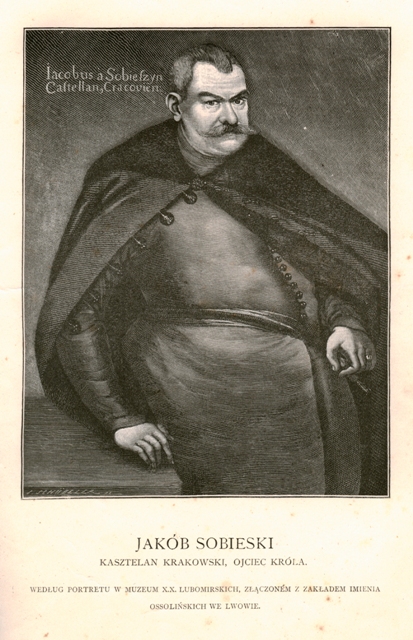
Jakub Sobieski (1590–1646), the youngest of children born to Marek Sobieski, the court Standard-bearer, came from rather impoverished nobility. No facts are known of his place of birth and childhood. Following his studies at the Zamość Academy and in Cracow, in mid-April 1607 he left Poland in pursuit of further education. He made detailed notes on his travels throughout Europe which lasted six years. Marek’s stay abroad helped him to learn foreign languages fluently, to improve his command of Greek and Latin, and last but not least to get acquainted with old and new scientific findings, to take lessons in horse riding, fencing, dancing, music and the like. In 1613 young Marek Sobieski returned to Poland as a well-educated man of the world and of broad political horizons. His return marked the beginning of a 25-year-long parliamentary career, in the course of which he was a member of parliament twenty times and a speaker of the lower chamber four times. He was an excellent public speaker, taking the floor at numerous public and private occasions. Consequently, he was granted the well-deserved title of “the Polish Demosthenes”. To this day his speeches are admired for their beautiful Polish language, a robust and fluent style and an overall expression.
Jakub Sobieski had extraordinary skills to preside over the lower chamber of parliament and the nobles at large. He was noted for his intelligence, superb reflexes, patience and acquaintance with national matters and the mentality of his noble mates. These qualities enabled him to work his way up the career ladder slowly but surely. In 1632 Władysław IV presented Sobieski with an affluent title of the Starost of Jaworów, in 1641 with the office of the Voivode of Russia, and finally in April 1646 with the rank of the Castellan of Cracow. Thus, Jakub Sobieski became a wealthy man, especially after his second marriage to Teofila née Daniłowicz. At the end of his life he owned 12 cities and towns and more than 170 villages. He died in his prime in June 1646 in his family estate in Żółkiew [Zhovkva] “of paralysis” resulting from a heated discussion with the king, in which he was allegedly insulted by Władysław IV for opposing the sovereign’s military plans.
The oil image of Jakub Sobieski, painted on canvas by a mediocre anonymous artist from Lviv in 1600–1650, is his only extant portrait (at present in the Lviv Gallery of Paintings, formerly in family gallery of the Żółkiew castle). Professor Mieczysław Gębarowicz observes that the painting, “is noted for an increased tendency to shape the form in relief and also for the characteristic expression, with the red żupan (traditional dress of Polish noblemen) and the red delia (a fur-lined coat) reinforcing the facial expression; the model’s face of swarthy complexion, dark eyes, thick brows and moustache as well as grizzled hair reveals some harshness”. The painting was copied a number of times in the nineteenth century in graphic form, lithography (inter alia by Sabina Karnicka, 1849) and woodcutting as exemplified herewith. Made by Julian Schübeler, the print originates from Józef Łoski’s album entitled Jan Sobieski, jego rodzina, towarzysze broni i współczesne zabytki [Jan Sobieski, his family, comrades-in-arms, and contemporary monuments] (Warszawa 1883).
Julian Schübeler, based on a painting by an anonymous Lviv painter from 1600–1650: Portrait of Jakub Sobieski, woodcut, publ. 1883.
We would like to inform that for the purpose of optimisation of content available on our website and its customisation according to your needs, we use information stored by means of cookies on the Users' end devices. You can control cookies by means of your Internet browser settings. Further use of our website without change of the browser settings means that you accept the use of cookies. For more information on cookies used by us and to feel comfortable about this subject, please familiarise yourselves with our Privacy Policy.
✓ I understand